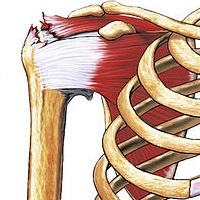
Photo from wikipedia
IntroductionRotator cuff tears are common and good-to-excellent clinical outcome is reported after subsequent repair. However, the retear rate of rotator cuff repairs has been shown to be as high as… Click to show full abstract
IntroductionRotator cuff tears are common and good-to-excellent clinical outcome is reported after subsequent repair. However, the retear rate of rotator cuff repairs has been shown to be as high as 20%. The reasons for retear seem to be multifactorial, mainly comprised by mechanical and biological aspects. Regarding mechanical causes, the role of the tendon tension and malreduction is so far unknown. First, we hypothesized that the tendon tension depends on the technique of tendon reposition and that malreduction of the tendon results in an increased tendon tension. Second, we aimed to demonstrate the inter- and intraobserver reliability of a novel custom-made digital tensiometer clamp.Materials and methodsA tendon defect of posterosuperior rotator cuff (reverse L-shaped) was simulated in seven cadaveric human shoulder specimens. By use of a custom-made tensiometer clamp, the supraspinatus tendon was reduced by pulling it in (1) an anterolateral direction (anatomical reduction) and (2) in a straight lateral direction (malreduction) until the footprint was completely covered. The reduction procedure was consecutively repeated to evaluate the inter- and intraobserver reliability.ResultsThe mean traction forces for anatomical reduction and malreduction were 16.02 N (SD 8.06) and 19.52 N (SD 9.95), respectively. The difference between the two groups was statistically significant (p = 0.028). The interobserver reliability showed a correlation of r = 0.757 [95% confidence interval (CI) 0.092–0.955]. The intraobserver reliability of the three surgeons was observed to be between r = 0.905 and 0.986.ConclusionsThe malreduction of the rotator cuff has a significant influence on the tendon tension and may therefore affect the healing rate of the tendon after the repair, so that a tension-balanced repair could improve the clinical results. Furthermore, the application of a novel custom-made tensiometer clamp showed good interobserver and excellent intraobserver reliabilities.
Journal Title: Archives of Orthopaedic and Trauma Surgery
Year Published: 2017
Link to full text (if available)
Share on Social Media: Sign Up to like & get
recommendations!